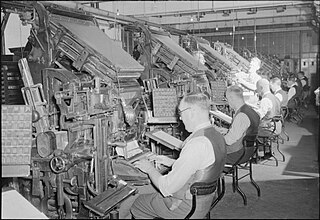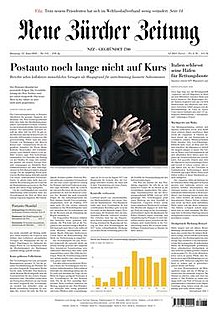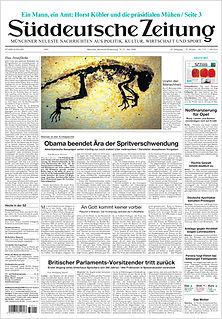Mass media of Germany includes a variety of online, print, and broadcast formats, such as radio, television, newspapers, and magazines.
Mass media of Germany includes a variety of online, print, and broadcast formats, such as radio, television, newspapers, and magazines.
The modern printing press developed in Mainz in the 15th century, and its innovative technology spread quickly throughout Europe and the world. In the 20th century period prior and during World War II, mass media propaganda in Nazi Germany was prevalent. Since the 1980s a "dual system of public and commercial" broadcasting has replaced the previous public system. [1]
Many in Germany read the weekly Der Spiegel . [1]
As of 2015, widely read national newspapers include Süddeutsche Zeitung , Frankfurter Allgemeine Zeitung , Die Welt , and Bild . [2] "Germans are voracious readers of newspapers and periodicals.... The economic state of Germany’s several hundred newspapers and thousands of periodicals is enviably healthy. Most major cities support two or more daily newspapers, in addition to community periodicals, and few towns of any size are without their own daily newspaper." [1]
The first "radio program in Germany was broadcast on October 29, 1923, in Berlin." [2]
The German video gaming market is one of the largest in the world. [3] The Gamescom in Cologne is the world's leading gaming convention. [4] [ non-primary source needed ] Popular game series from Germany include Turrican , the Anno series, The Settlers series, the Gothic series, SpellForce , the FIFA Manager series, Far Cry and Crysis . Relevant game developers and publishers are Blue Byte, Crytek, Deep Silver, Kalypso Media, Piranha Bytes, Yager Development, and some of the largest social network game companies like Bigpoint, Gameforge, Goodgame and Wooga. [5]
Journalism is the production and distribution of reports on events. The word journalism applies to the occupation, as well as citizen journalists who gather and publish information. Journalistic media include print, television, radio, Internet, and, in the past, newsreels.
Mass media refers to a diverse array of media technologies that reach a large audience via mass communication. The technologies through which this communication takes place include a variety of outlets.

The history of British newspapers dates to the 17th century with the emergence of regular publications covering news and gossip. The relaxation of government censorship in the late 17th century led to a rise in publications, which in turn led to an increase in regulation throughout the 18th century. The Times began publication in 1785 and became the leading newspaper of the early 19th century, before the lifting of taxes on newspapers and technological innovations led to a boom in newspaper publishing in the late 19th century. Mass education and increasing affluence led to new papers such as the Daily Mail emerging at the end of the 19th century, aimed at lower middle-class readers.

The news media or news industry are forms of mass media that focus on delivering news to the general public or a target public. These include print media, broadcast news, and more recently the Internet.

The Neue Zürcher Zeitung is a Swiss, German-language daily newspaper, published by NZZ Mediengruppe in Zürich. The paper was founded in 1780. It has a reputation as a high-quality newspaper and as the Swiss newspaper of record. The NZZ is known for its objectivity and detailed reports on international affairs.

The Kronen Zeitung, commonly known as the Krone, is Austria's largest newspaper. It is known for being Eurosceptic.
Berner Zeitung, also branded as BZ, is a Swiss German-language daily newspaper, published by Tamedia in Bern.

Kleine Zeitung is an Austrian newspaper based in Graz and Klagenfurt. As the largest regional newspaper in Austria, covering the federal states Styria and Carinthia with East Tyrol, the paper has around 800,000 readers.
The history of journalism spans the growth of technology and trade, marked by the advent of specialized techniques for gathering and disseminating information on a regular basis that has caused, as one history of journalism surmises, the steady increase of "the scope of news available to us and the speed with which it is transmitted. Before the printing press was invented, word of mouth was the primary source of news. Returning merchants, sailors and travelers brought news back to the mainland, and this was then picked up by pedlars and travelling players and spread from town to town. Ancient scribes often wrote this information down. This transmission of news was highly unreliable, and died out with the invention of the printing press. Newspapers have always been the primary medium of journalists since the 18th century, radio and television in the 20th century, and the Internet in the 21st century.

The modern newspaper is a European invention. The oldest direct ancestors of the modern newspaper were the handwritten news sheets that circulated widely in Venice as early as 1566. These weekly news sheets were filled with information on wars and politics in Italy and Europe. The first printed newspapers were published weekly in Germany from 1609. Typically they were heavily censored by the government and reported only foreign news, and current prices. After the English government relaxed censorship in 1695, newspapers flourished in London and a few other cities including Boston and Philadelphia. By the 1830s high speed presses could print thousands of papers cheaply, allowing for low daily costs.
Deutsche Zeitung in Norwegen was an Oslo-based daily newspaper published in Norway during the Second World War. It was published by the subsidiary Europa-Verlag of the Nazi-controlled Franz Eher Nachfolger, and had a circulation of about 40,000 copies. The paper served as a model for the Amsterdam-based Deutsche Zeitung in den Niederlanden.
Black Star, also known as Black Star Publishing Company, was started by refugees from Germany who had established photographic agencies there in the 1930s. Today it is a New York City-based photographic agency with offices in London and in White Plains, New York. It is known for photojournalism, corporate assignment photography and stock photography services worldwide. It is noted for its contribution to the history of photojournalism in the United States. It was the first privately owned picture agency in the United States, and introduced numerous new techniques in photography and illustrated journalism. The agency was closely identified with Henry Luce's magazines Life and Time.

African-American newspapers are newspapers in the United States serving African-American communities. Samuel Cornish and John Brown Russwurm started the first African-American periodical called Freedom's Journal in 1827. During the antebellum South, other African-American newspapers sprang forth, such as The North Star founded in 1847 by Frederick Douglass.
Mass media of Italy includes a variety of online, print, and broadcast formats, such as radio, television, newspapers, and magazines.
Mass media of Portugal includes a variety of online, print, and broadcast formats, such as radio, television, newspapers, and magazines. In the 20th century the Portuguese government censored the media, until the "1976 constitution guaranteed freedom of the press."
Mass media of Spain includes a variety of online, print, and broadcast formats, such as radio, television, newspapers, and magazines.

The Allgemeine musikalische Zeitung was a German-language periodical published in the 19th century. Comini (2008) has called it "the foremost German-language musical periodical of its time". It reviewed musical events taking place in many countries, focusing on the German-speaking nations, but also covering France, Italy, Russia, Britain, and even occasionally America.

The Süddeutsche Zeitung, published in Munich, Bavaria, is one of the largest daily newspapers in Germany.
The history of German journalism dates to the 16th century. Germany invented printing, and produced its first newspapers in the 16th century. However, Germany was divided into so many competing states that before unification in 1871, no newspaper played a dominant role.
| Wikimedia Commons has media related to Media of Germany . |